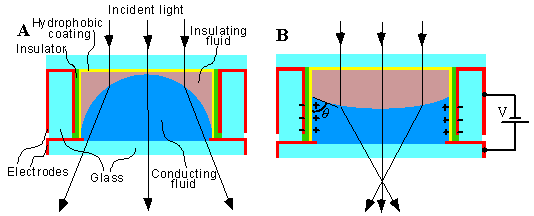Science Fiction
Dictionary
A B C D E F G H I J K L M N O P Q R S T U V W X Y Z
Philips FluidFocus: Variable Focus Fluid Lens

Philips FluidFocus - a variable-focus lens system with no mechanical moving parts - was demonstrated at CeBIT (Hannover, Germany) on March 3rd, 2004.


(See Philips' Fluid Lenses Bring Things into Focus.)
Update: Apparently, a French company, Varioptic, has previously claimed to hold "two fundamental patents" that cover this technology. See The $5 'no moving parts' fluid zoom lens - twice for more details.
Here's the scoop from the Philips press release:
"The Philips FluidFocus lens consists of two immiscible (non-mixing) fluids of different refractive index (optical properties), one an electrically conducting aqueous solution and the other an electrically non-conducting oil, contained in a short tube with transparent end caps. The internal surfaces of the tube wall and one of its end caps are coated with a hydrophobic (water-repellent) coating that causes the aqueous solution to form itself into a hemispherical mass at the opposite end of the tube, where it acts as a spherically curved lens.The shape of the lens is adjusted by applying an electric field across the hydrophobic coating such that it becomes less hydrophobic – a process called ‘electrowetting’ that results from an electrically induced change in surface-tension. As a result of this change in surface-tension the aqueous solution begins to wet the sidewalls of the tube, altering the radius of curvature of the meniscus between the two fluids and hence the focal length of the lens. By increasing the applied electric field the surface of the initially convex lens can be made completely flat (no lens effect) or even concave. As a result it is possible to implement lenses that transition smoothly from being convergent to divergent and back again."
(See the press release for very nicely done schematic diagram and more details.)
The lens consumes almost no electrical power, offers remarkable durability, is extremely shock-resistant and operates over a wide temperature range. The type of liquid doesn't matter, as long as they don't mix. At least one lens was constructed using soup - it rendered color poorly, so no soup lens on your next cameraphone. You could even use oil and vinegar, according to Philips' physicists.
Science fiction fans are of course familiar with Frank Herbert's oil lens from his extraordinary 1965 novel Dune. Herbert described it as "oil held in static tension by an enclosing force field within a viewing tube." (Thanks to Phil Gross for the tip on this one.)
Scroll down for more stories in the same category. (Story submitted 3/4/2004)
Follow this kind of news @Technovelgy.| Email | RSS | Blog It | Stumble | del.icio.us | Digg | Reddit |
Would
you like to contribute a story tip?
It's easy:
Get the URL of the story, and the related sf author, and add
it here.
Comment/Join discussion ( 2 )
Related News Stories - (" Engineering ")
Replace The Smartphone With A Connected Edge Node For AI Inference
'Buy a Little Dingbat... electropen, wrist watch, pocketphone, pocket radio, billfold ... all in one.' - Raymond F. Jones, 1945.
Sunday Robotics 'Memo' Bot Has Unique Training Glove
'He then started hand movements of definite pattern...' - Robert Heinlein, 1942
Tornyol Microdrone Kills Mosquitoes
'The real border was defended by... a swarm of quasi-independent aerostats.'
PLATO Spacecraft, Hunter Of Habitable Planets, Now Ready
'I ... set my automatic astronomical instruments to searching for a habitable planet.' Edmond Hamilton (1936).
Technovelgy (that's tech-novel-gee!) is devoted to the creative science inventions and ideas of sf authors. Look for the Invention Category that interests you, the Glossary, the Invention Timeline, or see what's New.
Science Fiction
Timeline
1600-1899
1900-1939
1940's 1950's
1960's 1970's
1980's 1990's
2000's 2010's
Current News
Replace The Smartphone With A Connected Edge Node For AI Inference
'Buy a Little Dingbat... electropen, wrist watch, pocketphone, pocket radio, billfold ... all in one.'
Artificial Skin For Robots Is Coming Right Along
'... an elastic, tinted material that had all the feel and appearance of human flesh and epidermis.'
Robot Guard Dog On Duty
I might also be thinking of K-9 from Doctor Who.
Wearable Artificial Fabric Muscles
'It is remarkable that the long leverages of their machines are in most cases actuated by a sort of sham musculature...'
BrainBridge Concept Transplant Of Human Head Proposed
'Briquet’s head seemed to think that to find and attach a new body to her head was as easy as to fit and sew a new dress.'
Google's Nano Banana Pro Presents Handwritten Math Solutions
'...copy was turned out in a charming and entirely feminine handwriting.'
Edible Meat-Like Fungus Like Barbara Hambly's Slunch?
'It was almost unheard of for slunch to spread that fast...'
Sunday Robotics 'Memo' Bot Has Unique Training Glove
'He then started hand movements of definite pattern...'
Woman Marries Computer, Vonnegut's Dream Comes True
'Men are made of protoplasm... Lasts forever.'
Natural Gait With Prosthetic Connected To Nervous System
'The leg was to function, in a way, as a servo-mechanism operated by Larry’s brain...'
Spidery 'Walk Me' Toyota Autonomous Wheel Chair Like Star Wars
Walk along with the emperor.
Dancing Robots Taught Dance Moves
'A clockwork figure would be the thing for you...'
Proof Of Robothood - Not A Person
'Who are you people? - Show 'em.'
Indonesian Clans Battle
'The observation vehicle was of that peculiar variety used in conveying a large number of people across rough terrain.'
The 'Last Mile' In China Crowded With Delivery Robots
Yes, it's a delivery robot. On wheels.
Tornyol Microdrone Kills Mosquitoes
'The real border was defended by... a swarm of quasi-independent aerostats.'
